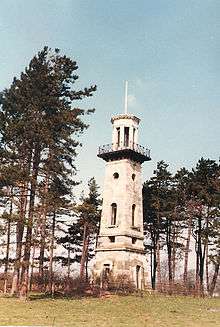Grimston Park
Grimston Park is a grade II* listed[1] Georgian country house in Grimston, North Yorkshire, England, some 1.7 miles (3 km) south of Tadcaster. It has been converted into a number of luxury homes.


The house is built on two storeys of Tadcaster limestone ashlar with a Welsh slate roof. It has a 7-bay frontage with a projecting portico and a three-storey tower and a single storey entrance lodge at each end. A limestone water tower in the grounds, designed like the house by Decimus Burton, is also grade II listed.[2]
History
In the early 1600s the Grimston estate belonged to the Stanhope family and King James I is recorded as staying there in 1603 on his way south to accept the throne of England. After some expensive litigation between members of the family over its ownership it passed to the Gascoignes of Parlington Hall, Aberford.
The estate and its previous building was bought in 1812 by John Francis Cradock, 1st Baron Howden. After his death it passed to his son John Hobart Caradoc, 2nd Baron Howden who had served in the Diplomatic Service in Russia, where he married the Russian princess, Catherine Bagration, the widow of Pyotr Bagration. The second baron commissioned Decimus Burton to rebuild the house in 1839 as an "Italianate palace" with large pleasure grounds and a Riding School. Unfortunately the Howdens divorced after 11 years and the estate was sold in 1851 to fellow diplomat Albert Denison, 1st Baron Londesborough.
In 1872 the estate, comprising the Hall itself and 600 acres of parkland, together with the outlying farms making up a total of 2875 acres was bought for £265,000 by wealthy cotton manufacturer and MP John Fielden, known as "Honest John". On his death in 1849 it passed to his second son, also John, who was appointed High Sheriff of Yorkshire for 1885. He left it on his death in 1893 to his nephew Thomas, MP for Middleton, who died unexpectedly at an early age in 1897. His eldest son, who inherited the estate, was Captain John Fielden, an Eton educated Army cavalry officer.
Parts of the estate were used by the RAF for military purposes during the Second World War. In the late-1960s, the house and its contents went on the market. There was a sale catalogue in the library 'stacks' in Temple Newsam house up to the mid-1990s which may by now have been rehoused. Fully illustrated in colour, the catalogue showed Grimston Park mansion still in its full country house style. By the mid-1970s, the estate was bought by an organisation called 'Historic Productions' and the stables were converted to form a 'mediaeval banquet hall'. Local people and students from Leeds College of Music were hired to supply both music and meals. The singing waitresses were decked out in boldly pattern brocade dresses and served 'brose', 'manchet bread' and roast chicken legs. Music consisted of popular late Georgian and Victorian ballads, but the string and keyboard players did their best to introduce some authenticity. At this time, what must have been delightful Italianate gardens to one side of the house, were entirely and genuinely romantically, overgrown. The front lawns and the great iron gates had been well looked after and the famous double row of Augustan caesars was still standing.
The house has since been sold and converted into 11 individual luxury residences, though the adjacent parkland still remains in the ownership of the Fielden family. Some outbuildings have been converted to workshops.
References
- Historic England. "Grimston Park (1168029)". National Heritage List for England. Retrieved 29 July 2015.
- Historic England. "Grimston Tower (1168018)". National Heritage List for England. Retrieved 29 July 2015.
- "About Grimston Park estate". Retrieved 11 March 2013.